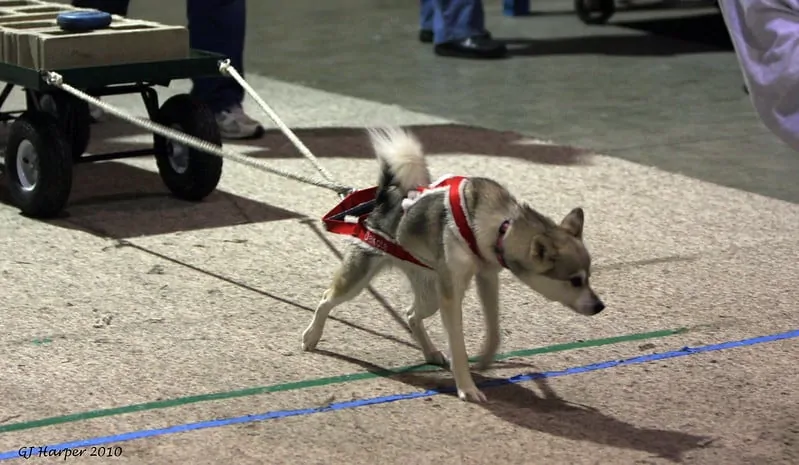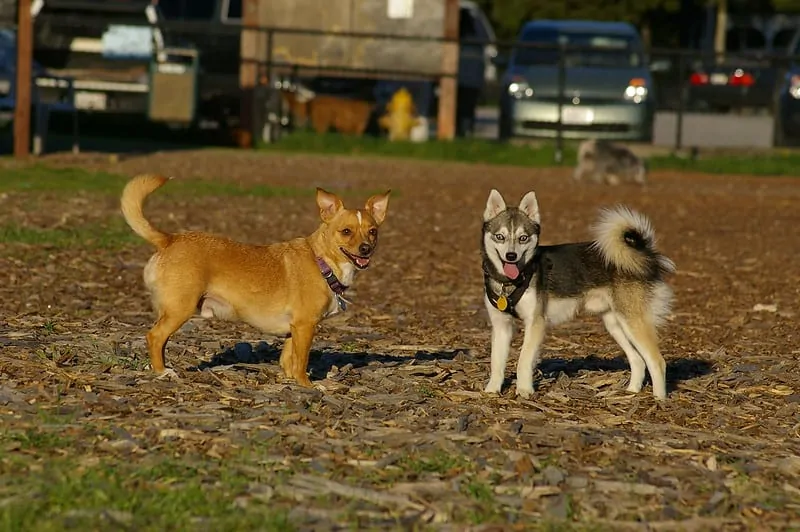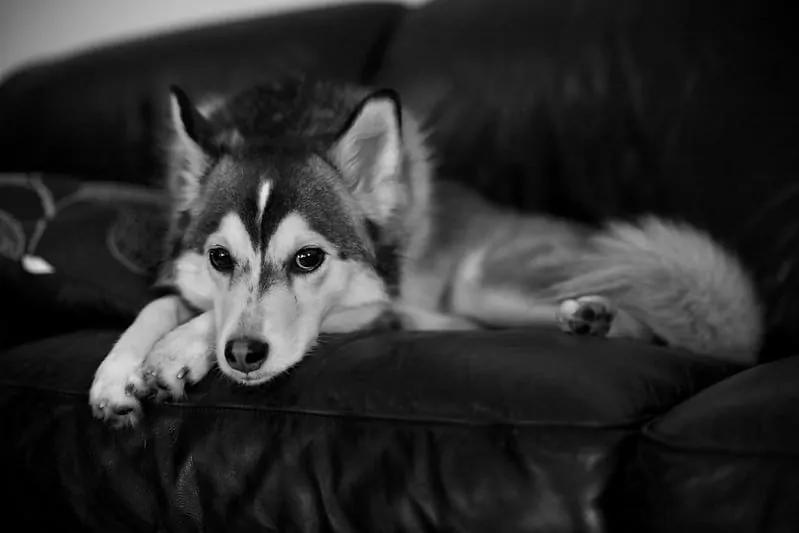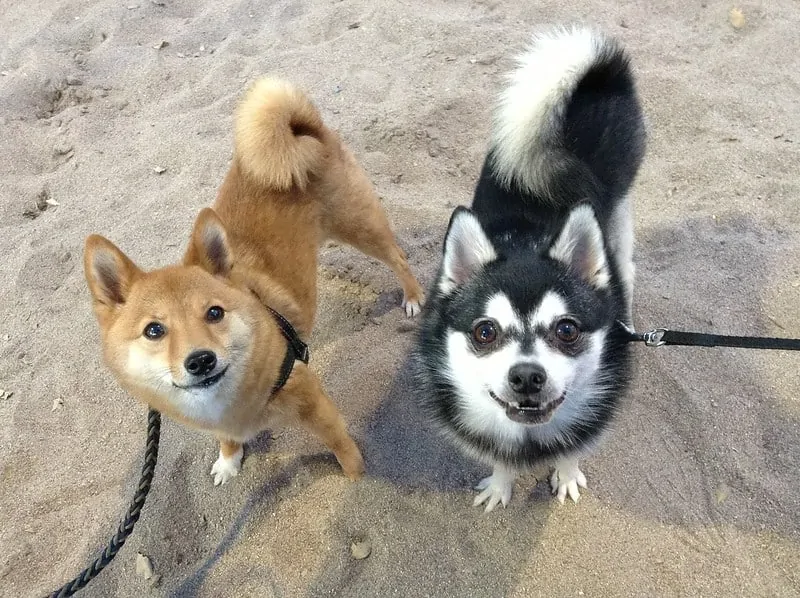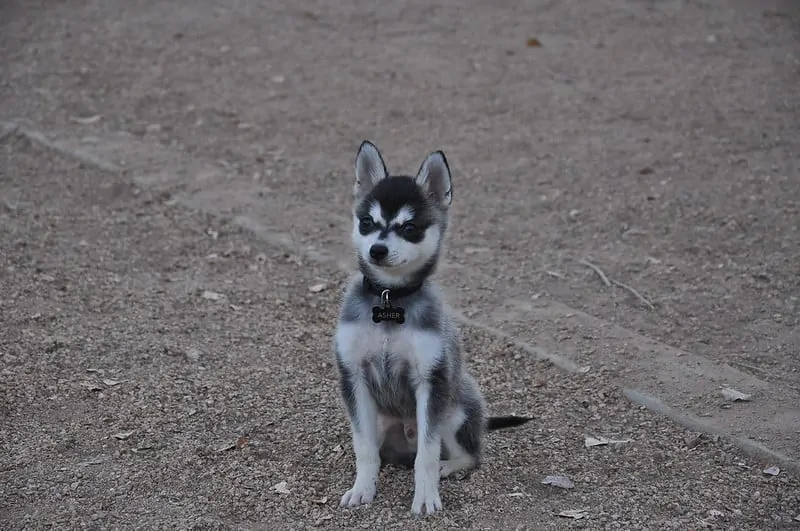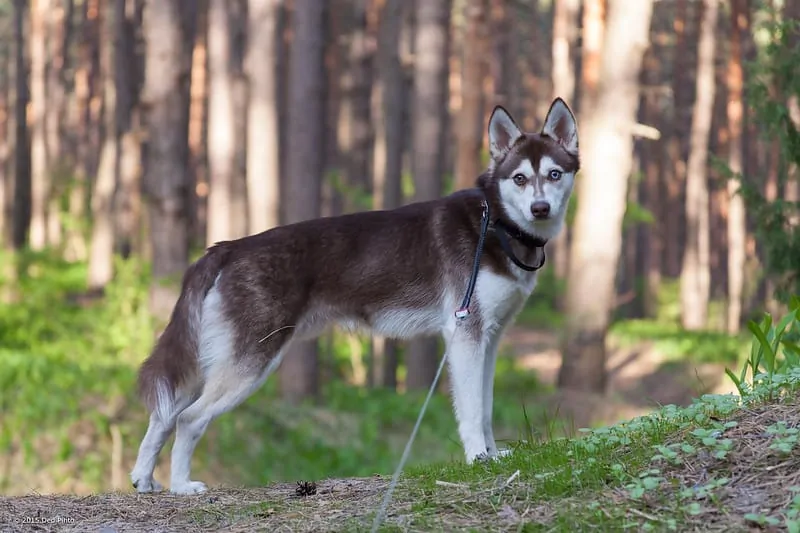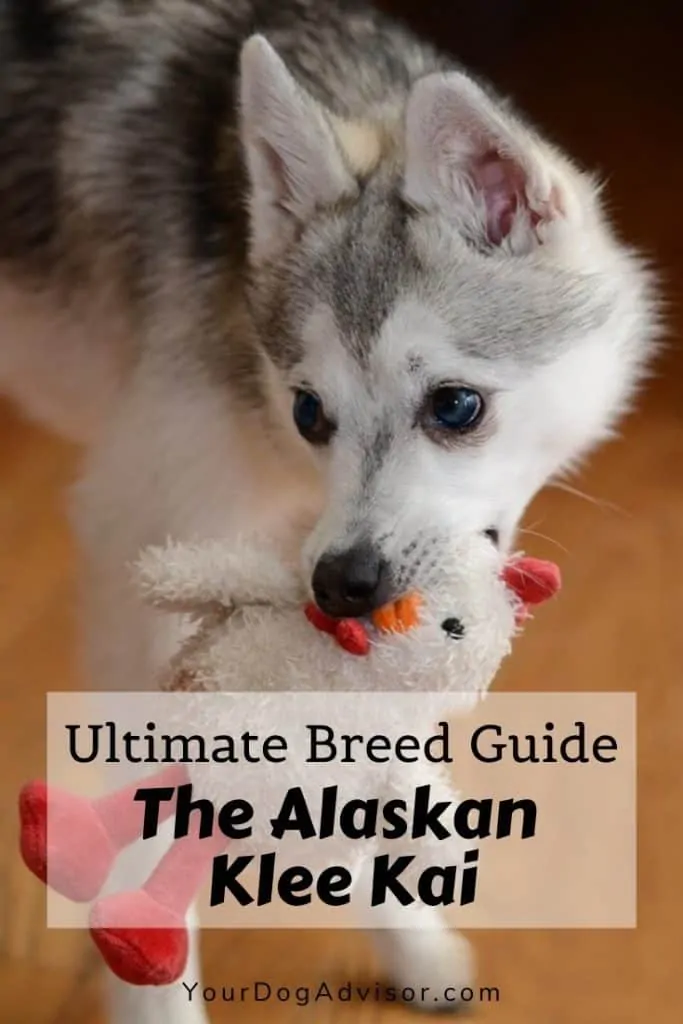As a miniaturized version of the very popular Alaskan Husky, the Alaskan Klee Kai is one adorable pup that is sure to turn a few heads. But these tiny spitz dogs aren’t always keen on such attention. And that’s not the only way the Alaskan Klee Kai differs from their larger doppelgangers.
Keep reading to learn more about these lil’ Huskies’ personalities and to find out if the Alaskan Klee Kai might be the right fit for your family.
Contents
General Characteristics of the Alaskan Klee Kai
- Other names: Klee Kai
- Height: Toy – up to 13 inches; Mini – 13 to 15 inches; Standard – 15 to 17 inches
- Weight: 5 to 22 pounds
- Lifespan: 10 to 13 years
- Origin: Alaska, USA
- Colors: Shades of black, grey, or red with white or cream markings.
- Activity level: High
- Grooming needs: Low to moderate
- Best suited for: Experienced small dog breed owners
They may be tiny, but these mity dogs still retain a lot of their forebearers’ instincts. Keep reading to learn where these tiny spitz dogs came from and what kind of pets they make. “Weight Pull 21410 111KleeKai” by Tundra Ice / CC BY-NC-ND 2.0
The History of the Alaskan Klee Kai
The tiny Alaskan Klee Kai has only existed for about fifty years and has been available for public purchase for even less time.
In the early 1970s, a woman named Linda Spurlin decided she wanted to try and create a companion sized husky-type dog. Linda Spurlin was living in Alaska at the time, but it was actually on a trip down to the contiguous US that she saw a very petite Alaskan Husky and got the idea to intentionally breed a smaller line.
Unlike many miniaturized versions of existing dog breeds, Spurlin did not try to accomplish a smaller Alaskan Husky simply by breeding small representatives from the breed.
Because this type of breeding practice typically involves a small dog gene pool and the use of dogs with less than desirable genetic traits, it often leads to lines of dogs with multiple health problems.
Instead, Spurlin bred smaller spitz dogs like the American Eskimo and the Schipperke with the Alaskan Husky and Siberian Husky.
After multiple generations, she achieved some uniformity among the puppies she was producing. Though, compared to older breeds, the Klee Kai has a great deal of variation from one litter to the next. That is one reason why these dogs come in three different sizes and one reason the personalities can change greatly from dog to dog.
Unlike many small dog breeds that are produced through genetic mutations that cause dwarfism, or shortened limbs, the Alaskan KK was created by breeding Huskies with established small spitz breeds. “Perky & Wolfy” by Michelle Ress / CC BY-NC-ND 2.0
The toy Alaskan KK is the smallest representative of the breed with some dogs maxing out at only 5 pounds and less than a foot tall. The next largest dog, the miniature AKK, is about the size of Schipperke. The largest type, the Alaskan KK, can be up to 17 inches and around 23 pounds.
While this dog truly encompasses the idea of a strictly companion Husky, the typical size is the perfect pooch for someone who likes to hike, jog, or otherwise be active, but doesn’t have the room for a full-sized sled dog.
After breeding the dogs for generations with the help of family, Spurlin finally made the breed available to rare breed enthusiasts everywhere and started selling the first puppies in 1988.
While the breed is still not officially recognized by the American Kennel Club, it is a registered breed with the United Kennel Club under the official name Alaskan Klee Kai.
The Temperament of the Alaskan Klee Kai
Since this little dog has only been a uniform dog breed for a few decades, the temperament can vary widely from puppy to puppy.
In general, the Alaskan Klee Kai (AKK) is a loyal and loving dog with family but, true to their spitz nature, they can be aloof and standoffish with strangers. This can be a difficult trait to deal with, especially for an adorable micro Alaskan Husky that catches the attention of everyone they meet.
Established breeds that have been used for a single purpose for hundreds of years tend to have consistent temperaments from dog to dog. Newer breeds like the AKK, on the other hand, have more genetic variation in these areas, making it hard to predict if you will get a very social, friendly dog, or more of a shy cat-like pooch. “Dolce Chilling on the Couch” by Jonathan Mueller / CC BY 2.0
There has been a focused attempt by many breeders to improve this aspect of the dog breed’s temperament and produce puppies that are more confident and interested in those they don’t know. If that is an important trait for your future dog, you will have to do some extra research into breeders and try hard to find a breeding pair that are happy to greet you when you come for a visit.
In terms of activity level, this dog breed has the stamina of the Husky and the jittery energy of a toy dog breed. They need a lot of exercise and especially enjoy long walks and playing off-leash in the yard. If you fail to tire out your Alaskan KK before leaving them home alone, you are likely to return to some destruction.
Like Huskies, these dogs don’t bark much but they are very vocal, especially when playing or unhappy. They tend to make a lot of “woo-woo” noises and will even scream if frightened or injured.
As long as you can provide enough activity to keep the destruction and noise to a minimum, they do make great apartment dogs. They are an especially good choice for active individuals who don’t have the space for a larger dog.
Like other spitz breeds, the Klee Kai is very intelligent and somewhat independent. They typically learn basic obedience skills quickly, as long as you can keep them motivated.
Their agile and active nature make them great candidates for dog sports, especially agility and rally.
Overall, the AKK is an affectionate pet but doesn’t always like strangers. They are active and love to have fun, but are easy to keep in small spaces. They aren’t exactly a Husky in a smaller body, but they come very close.
Learn more about the AKK in the above video.
Health Issues Common to the Alaskan Klee Kai Breed
There is a short list of health issues that plague the AKK breed. Luckily, since there are only a handful of people breeding these dogs, it has been easy to target certain health issues and breed away from them. Still, it is good to be aware of what problems might crop up in your dog.
Here are the most common health issues seen in the Alaskan KK.
- Cataracts
- Thyroid disease
- Heart defects
- Liver shunts
- Luxating patella
- Factor VII deficiency
One of the more specific conditions that plagued the dog breed early on is one known as factor VII deficiency.
This is a protein produced by the liver in both people and dogs. It has roles in many aspects of the blood clotting process. Dogs affected by factor VII deficiency will experience prolonged or excessive bleeding after an injury or surgery.
Despite being active dogs, Alaskan KKs aren’t immune to gaining a little extra weight. Feeding the right amount for your dog’s specific size is key to maintaining their overall health. “In Hiding” by Crimsong 19 / CC BY-NC-ND 2.0
If your dog suffers from this condition you may notice symptoms such as frequent nose bleeds, bleeding gums, hot swelling around joints, or excessive bleeding after their spay or neuter surgery.
There is no cure for this disorder, but it can generally be managed by monitoring and precautionary measures to avoid injury. If your dog needs surgery or experiences an injury, they may need medication or a transfusion of clotting factors to stop or prevent excess bleeding.
Luckily, there has been a focused effort by Alaskan Klee Kai breeders to remove individual dogs from the breeding pool who carry this rare recessive gene. Today, it is very unlikely that your Klee will suffer from this disease, so long as you choose your breeder wisely.
Do Alaskan Klee Kais Do Well With Children and Other Pets?
Despite being standoffish or even skittish with strangers, AKKs do tend to do well with children in their family. They love to play and an older child makes the perfect companion to help them burn off that excess energy.
These dogs, especially the toy variety, can be quite small, however, so it is important that any child-dog interactions be monitored to make sure the dog is comfortable and not at risk of being injured.
The Alaskan KK tends to be a very social dog when it comes to other canines, despite how shy they can be around people and how feisty they can be with other types of animals. “Old Friends: Taro Shibu Inu & Asher Klee Kai” by Taro the Shibu Inu / CC BY 2.0
It is also worth noting that more reserved or fearful Alaskan Klee Kais may not do well around friends of children since they are so wary of strangers. It is best to monitor your dog closely in these situations and remove them from the area if they are not enjoying their new playmates.
In terms of getting along with other dogs, Alaskan KKs tend to be quite social. This likely has a lot to do with the Husky blood that went into creating them. Huskies have long been used to work in teams and must get along well with other dogs to do their jobs.
Alaskan Klee Kais have never had to pull a sled, but that instinct to run in a pack is still very much intact. They typically enjoy playing and do well in households with multiple dogs. Toy breeds may require smaller playmates to avoid injuries, but the typical sized dogs can typically hold their own with other well-socialized dogs.
Another dog that went into creating the AKK is the Schipperke. These dogs were bred to hunt and kill rodents. That same prey drive is still alive and well in Klee Kais today and can make them a hazard in homes with other small furry pets.
It may be possible for some AKKs to live alongside cats and other animals, but it should not be expected. For the best chance at a harmonious household, Klees should be introduced to many other animals including dogs from puppyhood.
What to Consider Before Bringing Home an Alaskan Klee Kai
Think the tiny Husky sounds like the perfect dog to add to your family? Here are a few more things to consider first.
This little face is hard to deny, but before you buy an AKK on a whim, be sure you are prepared to care for this unique little dog for life. “Asher the Klee Kai Sits Like Champ” by Taro the Shibu Inu / CC BY 2.0
Activity Level
These dogs are active well into their golden years. Expect to have to walk your AKK at least once a day and provide some mental enrichment as well. These dogs can be somewhat cat-like and are good at entertaining themselves (and you) but only when they get enough exercise.
Consider signing your Klee up for agility or another fun hobby to keep them engaged and active in a positive way. These little athletes were built for all types of dog competitions and the early exposure to different situations will help them be less shy as adults.
Trainability
The AKK is very intelligent but not always willing to listen to their owners. You will need to encourage your dog to learn new behaviors by keeping things exciting and rewarding them with praise, treats, or whatever else motivated them. Keeping training sessions short will also help them from getting bored or distracted.
Their small size and agile nature make the Alaskan Klee Kai a great candidate for trick training as well.
Grooming
They may not have a lot of surface area, but somehow these dogs do have an awful lot of coat. Like Huskies, AKKs traditionally have a short, thick double coat, though some sport the longer version. In either case, expect your Kai to shed all year long with big “blowouts” in the spring and fall.
Aside from having to vacuum frequently, there isn’t a lot of work involved in grooming an AKK. Much like cats, they prefer to bathe themselves. Multiple short brushing sessions each week and the rare bath should be enough to keep this notoriously clean breed looking their best.
Unlike most dogs, the AKK lacks a noticeable doggy odor. They tend to be very clean animals and rarely need to be bathed, though they do require frequent brushing. “Asher Hanging Out on the Volleyball Court” by Taro the Shibu Inu / CC BY 2.0
Nutrition
The Klee will do well on any high quality homemade, raw, or commercial dog food. While they tend to be very active, some have inherited the Husky metabolism, allowing them to store fat even when their calorie consumption is very low. To counteract this and to keep your dog trim and healthy, make sure to portion out meals and make adjustments based on your dog’s body condition.
Cost
This rare dog breed will cost you. The average purebred puppy goes for between $1,500 and $3,000.
Their small size and relatively clean health record mean they are likely to cost less than the average dog breed to own. Still, owning any dog is a commitment and you should strongly consider if you can provide a home for a dog for life before ever purchasing or adopting one.
9 Fun Facts About the Alaskan Klee Kai
Now that you know what it takes to own a mini Husky, here are some fun facts about the dog breed.
- The dark mask and wide line on the ridge of the muzzle are dog breed characteristics of the AKK and any dog without one is faulted in the show ring.
- It isn’t uncommon for these dogs to retain their baby teeth and need dental surgery to remove them once their adult teeth start to come in.
- It is possible to find all-white AKKs but they fall outside the dog breed standard and are very rare.
The Alaskan KK comes in three sizes. While the smaller mini types tend to have the large eyes and rounded features of small dog breed dogs, the standard Kai tends to look most like a true Husky. “Alaskan Klee Kai” by Ded Pihto / CC BY-NC 2.0
- Like Huskies, AKKs can have blue, brown, or yellow eyes or, sometimes, even two different colored eyes.
- These dogs sometimes suffer from separation anxiety due to the tight bonds they form with their owners.
- These same close bonds also mean these dogs don’t always rehome well. Which is another reason to make sure you are committed before you get one of these unique dogs.
- These are not great dogs for off-leash walks since they have such a high prey drive and don’t always recall well.
- Sophie Turner, the famous Game of Thrones actress, owns two Klee Kais.
- The name “Klee Kai” literally means “little dog” in the Inuit language.
Before You Go
Not sure an AKK is the right fit for you? Here are a few more dog breeds worth considering.

Sara Seitz has spent most of her life in the pet industry and has a bachelors in animal behavior from Colorado State University. Sara started working with dogs and cats as a high schooler at a rural boarding kennel. There she learned a lot about the bad and the ugly of the pet service industry. But not even the toughest day at that job would dissuade Sara from following her dream of working with animals.
In college, Sara got a job at a dog daycare and boarding facility in Fort Collins, Colorado. Her new career provided even more opportunities for learning about dog behavior than her classes did. As general manager of the daycare, Sara helped the company launch a new in-home pet sitting branch and trained to become a certified dog trainer. Between shifts taking care of peoples pets in-home and supervising dogs during playtime at the daycare, Sara organized and taught obedience classes.
Sara has always been passionate about bettering the lives of our canine companions. She soon found that advocating for and educating owners in the power of positive reinforcement training was one of the best ways to help dogs and their owners live happier lives.
